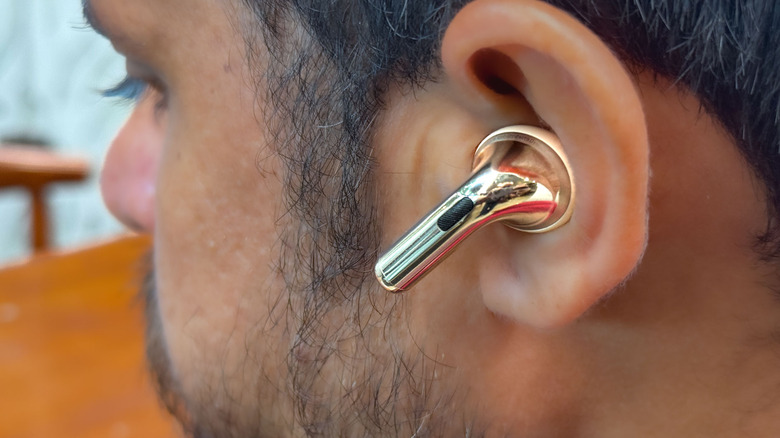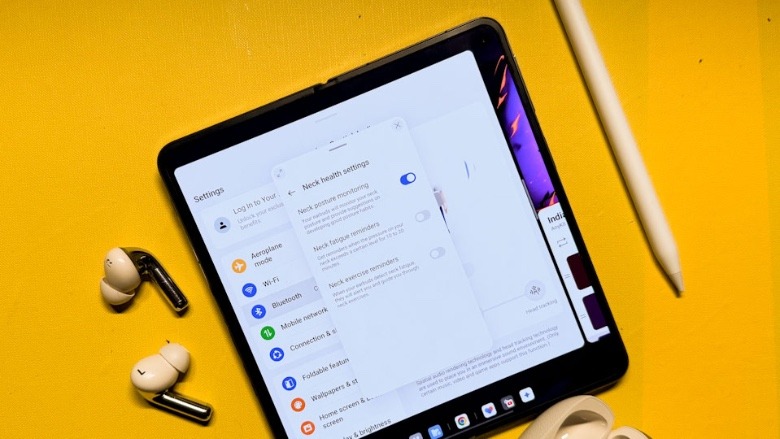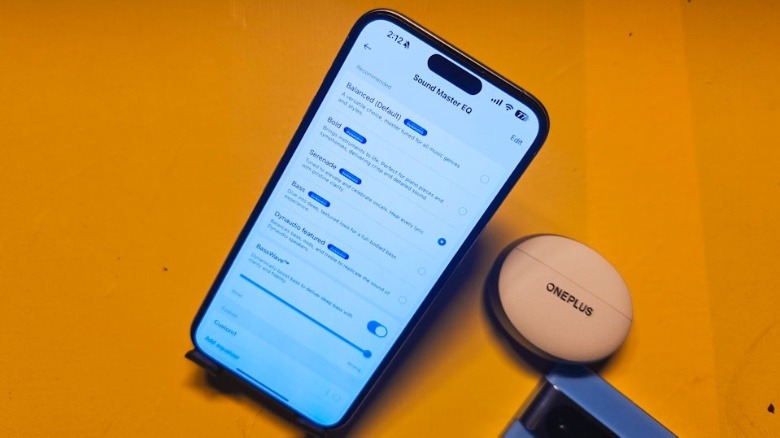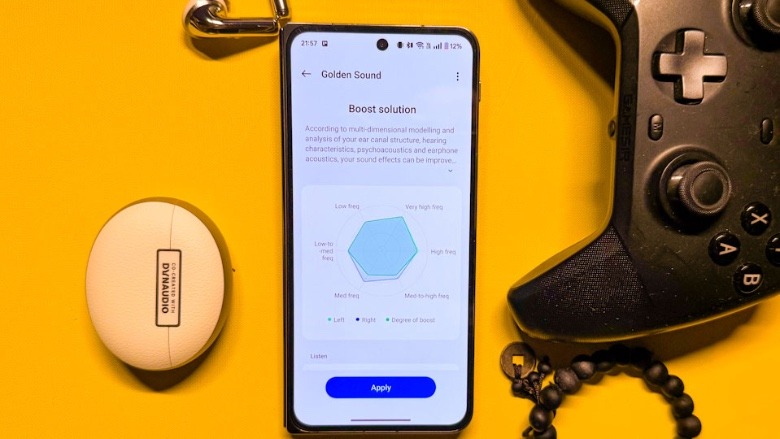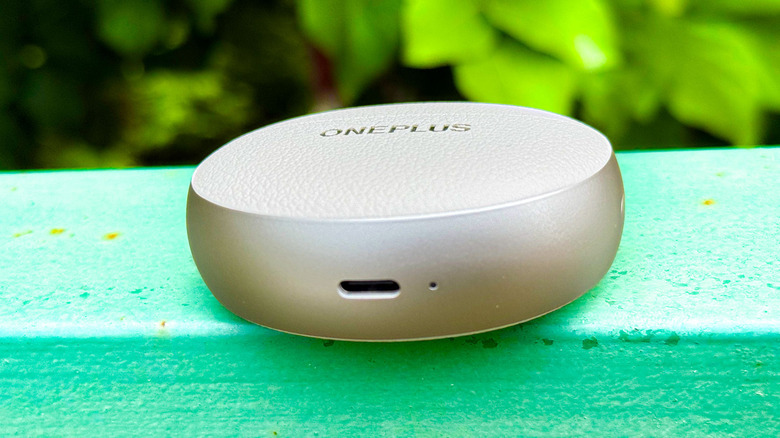OnePlus Buds Pro 3 Review: A Major Win For Top-Tier Earbud Audio
- Opulent looks and solid feel
- Vibrant sound with smooth bass
- Accurate head-tracked Spatial Audio
- Reliable noise cancellation
- Impressive battery life
- Neck health tools are a nice touch
- Pinch and slide gestures work well
- Full benefits reserved for OnePlus phones
- Device switching is a bit slow
- EQ presets don't make much of a difference
- Aggressive spatial audio is irksome
- Lack of ingress protection for the case
- ANC interferes with mic output on calls
The sum of all parts. That's the best way to describe the OnePlus Buds Pro 3. Building up on the OnePlus Buds 2 Pro, the company took a solid formula and souped up the whole experience by giving an extra lift to the raw audio quality and addition of some new features. Now, there aren't any fundamental changes from a hardware perspective, with the exception of a bone conduction sensor to improve call quality.
This time around, the company has paid special attention to the design, ditching the boxy looks of its predecessor in favor of a OnePlus Nord Buds 3 Pro-esque format. Renowned Danish audio brand, Dynaudio, has once again lent a helping hand to tune the sound output and add a dedicated sound EQ of its own.
OnePlus has complemented its existing suite of personalization tweaks with a neat health-centric update, and improvements to the noise cancellation performance, as well. Overall, the OnePlus Buds Pro 3 seems to be a well-rounded pair of wireless earbuds at $180, but not without a few hiccups and questionable product decisions along the way. OnePlus sent a pair of Buds Pro 3 to test for this review.
Luxurious build, one hard miss
The Buds 3 Pro follow the same aesthetic formula as their predecessor, but instead of a two tone design on the stem, OnePlus has aped the looks of the vanilla OnePlus Buds 3 with a few modifications in tow. The vent position and size has changed and it now resembles what Apple did with the AirPods Pro 2. The choice of materials used is more premium on the latest earbuds, and we also get a new Lunar Radiance color option, in addition to the Midnight Opus aka black edition.
The earbuds themselves are also a bit heavier, which can be attributed to the modifications under the hood. The case, however, is an altogether different story. The oval case, reminiscent of the Nord Buds 3 Pro, has been treated to a faux leather finish. Paired with an understated lustrous paint job on the sides, this charging case feels noticeably more premium than any wireless earbuds I've used so far. Only the Marshall Minor III comes close to matching the luxurious feel that you get on the OnePlus Buds Pro 3.
The company also supplies a total of four eartips in the retail package, alongside a cable with a USB-A connector at one end (instead of the more reasonable USB-C to USB-C.) Why, OnePlus? There's another disappointment here. While the earbuds retain their IP55-level dust and water resistance, the charging case doesn't. That's quite some questionable regression, as the OnePlus Buds Pro 2 offered at least IPX4 level protection against liquid exposure.
Fit and comfort
The OnePlus Buds Pro 3 are not too different from their non-Pro trim when it comes to design and fit. In a nutshell, they remain snugly nested in the ear canal. Over a week, I took them jogging, some yoga, and cycling, and I never ran into an instance where I had to re-adjust the earbuds to prevent them from falling off. For my unique ear shape, the "L" size earbuds offered the most secure fit with the least amount of sound leakage.
But if you seek an even better experience, get yourself some silicone foam eartips. I had a spare pair, and they yielded better results than the supplied rubber-based eartips. There's an earbud fit test that plays tunes in your ears to find the best fit and eartip size. Depending on the data collected by the onboard sensors, the mobile app rates the fit as good or average, asking users to make position adjustment or try another eartip option for the tightest fit and tightest ear seal.
This approach also ties into the Golden Sound feature, which performs a similar test to gauge the unique ear canal shape and hearing assessment to deliver personalized audio. I highly recommend that you go through these tests, even though it takes a few minutes worth of patience. The earbuds also come with a bone conduction sensor (VPU) that combines mic and sensor input to enable clear conversations on a call.
Audio output
The OnePlus Buds 3 leaned more heavily towards a strong bass output. The Pro version, on the other hand, aims for enhanced depth and a wider soundstage instead of enthusiastically favoring the low frequencies. On the new earbuds, OnePlus says it has added an extra magnet to the main 11mm audio driver and has switched the diaphragm build to a ceramic-metal composite material. The result is extra sonic punch, higher sensitivity, and improved accuracy.
The level up in sound quality is quite apparent, and it seems OnePlus was after the same kind of sonic signature as the Sony WF-1000XM5 flagship earbuds. But there are a few differences. A higher level of immersion is the signature trait of the OnePlus Buds 3, which means it tends to exaggerate the mids and highs, in an attempt to create a more echo-ey feel. Luckily, to a large extent, it doesn't mess up a track's overarching instrumental balance.
You can still discern the nuances, but at the cost of the certain vocal styles losing a bit of their identifying trait. Listening to Persian hit "Nashkan Delamo," the husky tones of Mohsen Chavoshi's vocals sound a tad piercing, compared to the relatively flat output from the Samsung Galaxy Buds 2 Pro and the latest Nothing Ear earbuds. Yet, the natural tenor of Moein and Siavash Ghomayshi's soft baritone came out beautifully in "Parendeh," retaining the unique Perso-Arabic lifts and drops without suppressing the background tones.
Hits and misses
Compared to OnePlus' previous attempts, the Buds Pro 3 is a breath of fresh air. Yet, they aren't quite an audiophile's dream, as high-res audio playback only goes as far back as LHDC (v5.0) and frequency range maxes out at 40KHz, falling slightly short of what Apple Music classifies as the peak for CD-Quality or Lossless. But don't let those numbers dissuade, and certainly not at this price point.
There are a whole bunch of EQ presets available, if you don't want to fiddle with custom EQ sliders and create your own unique listening profile. The options include bold, serenade, bass, and Dynaudio, each with its own flavor based on what it amplifies. You won't feel much of a difference jumping between these EQ presets, which is a shame.
Unless, you enable Spatial Audio, which seems to magnify the entire set of frequencies, making it easier to spot the change in sonic output between each preset. But it doesn't always work. For example, listening to Hans Zimmer's "Lost but Won," you won't run into any glaring issues. The trombones and violin rhythms sound lovely, but you lose the thumping drums and the inverted V-shaped tempo of the instrumental masterpiece.
At high volume levels, a healthy bunch of instrumental tracks start sounding somewhat chaotic, particularly original motion film and game soundtracks that build up slowly. Overall, the ANC and transparency controls don't serve any major red flags, but they could use a bit of refinement.
Special features
There are a handful of other niceties that add to the OnePlus Buds Pro 3's appeal. You get support for Google Fast Pair, alongside simultaneous multi-device connectivity. The latter works fine, but there's a delay of around 2-3 seconds when you hit pause on one device and tap the play button on another paired device. There's Zen Mode Air, which pumps calm, nature-inspired white noise into your ears.
Then there's Neck Health, which monitors the neck posture, and also sends reminders about neck fatigue and basic exercise for relaxing the muscles. It ties into OnePlus' "OHealth" wearable health ecosystem. This one creates a graphical log of your neck posture for the entirety of your earbuds usage time, breaking it down across pressure percentage and head-down time.
There's also a neck mobility test which performs seven basic tests for posture assessment and a separate neck exercise dashboard that guides you through three types of workouts. It's a thoughtful addition, especially for folks hunching on their workstation while staring at a computer's screen for hours, or even slouching on a couch.
In-ear detection works reliably, and there's also the convenience of using the earbuds as a remote shutter button for clicking pictures with a paired phone's camera. Finally, you've got the dedicated Hi-Res mode. But toggling it on or off requires a full disconnect and fresh pairing. It's also a bit confusing, since there's another toggle in the settings section for HD/LHDC audio playback.
Transparency and noise cancellation
OnePlus has improved the noise cancellation performance in its latest flagship outing, both numerically and realistically. You can pick between three levels of noise cancellation. However, the Smart mode, which makes automatic adjustments based on the external noise, works best. In a cafe brimming with human chatter and speakers playing lo-fi beats, the ANC completely drowned the noise with music volume set close to the 70% mark.
Outside, it also did a fair job of silencing the sound of vehicles passing by and the pedestrian noises, but the jarring noise of cars honking and engines revving at a traffic signal still passed through. But compared to the Nothing Ear, the OnePlus Buds Pro 3 delivered a better noise isolation experience. The transparency mode also works fine and does a good job at amplification, even though it's a tad more aggressive than what I've experienced on the AirPods Pro.
I noticed a hiss-like white noise every time I enabled transparency mode, but after a fresh setup and ear canal analysis, it receded considerably. However, I did run into a weird issue. With ANC enabled, the onboard mics seemed to malfunction during voice calls. The person on the other end often complained of a muffled voice. But when I enabled transparency mode, the conversation went seamlessly.
Spatial music
Beyond all the snazz and jazz, there are forfeitures at play. When listening to music, enabling Head Tracking for Spatial Audio disturbs the dynamics. Moreover, if you're listening to a vocal-heavy melodious track, the voice is amplified, and in a somewhat jarring way where the pitch is raised and the timber also starts sounding slightly synthetic. Needless to say, if you're into classical music or tracks where the vocals do the talking, you should keep head-tracking disabled.
Now, Spatial Audio itself is a divisive theme in the audiophile community. But more importantly, the experience also depends on how well a particular track or audio-visual content has been mixed. At the end of the day, it's also up to a person's preference. On the positive side, the directional channel separation works really well and adjusts the perceptive spatial audio quite reliably with respect to head movements. The audio positioning is precise with acceptable channel distinction, letting you perceive sonic motion as it transition across the soundstage.
Spatial Audio comes to life at high-tempo music with generous percussion, keyboard beats, and bass-heavy undertones. But the same can't be said for all genres. When head tracking is enabled, it absolutely butchers Rihanna's smooth vocals in "Don't Stop The Music" at high volume levels, while the backgrounds sound unbearably shrill. But if you are into genres like R&B, EDM, and phonk, just enable the BassWave toggle, crank it all the way up to level 5, and enjoy the thumping bass.
Battery and controls
The OnePlus Buds 3 Pro support wired fast charging, and wireless charging convenience is also part of the package. The size of the battery fitted inside the earbuds has shrunk ever so slightly, but compared to the OnePlus Buds Pro 2, the case on the upgraded version packs a larger Li-ion unit. Interestingly, OnePlus says the earbuds can last an hour longer, while the earbuds + case combination adds an extra four hours worth of listening time, reaching a combined 43 hours.
I didn't run an endurance test on the exact same test stipulations as OnePlus prescribes, but the battery life has been pretty impressive so far. After a listening session worth four hours — with sound levels always above the 80% mark, ANC enabled, quality set to Hi-Res, and a few jumps in and out of Spatial Audio — the earbuds' battery level only fell to about 30% in the most recent test run, which is quite impressive. Those endurance figures put the OnePlus Buds Pro 3 ahead of the second-gen AirPods Pro.
Another win for these earbuds is controls. OnePlus has shifted the controls to the stem, creating a fingerprint-like rough surface on one side so that it's easier to locate the touch-sensitive area. It supports squeeze gestures for media playback and ANC/transparency controls, while sliding up and down adjusts the volumes. The whole system works reliably, and there's also a satisfying clicking sound after the stem registers a pinch gesture.
Verdict: It's an easy pick
The OnePlus Buds Pro 3 are a moderate refinement, with a focus on winning the aesthetics battle while simultaneously inching closer to a sophisticated audio output that is usually reserved for expensive earbuds. Now, depending on how seriously you take versatility and experimentation with your daily music listening, you may find them to be a class apart, or just another pair of very good earbuds that make the AirPods Pro feel like cheap plastic trinkets.
However, once again, OnePlus is keeping some of the niceties limited to its own phones, but the Hey Melody app still covers all the basics. Noise cancellation has improved, yet there is still some room for transparency refinements. The battery life figures aren't bad either, and wireless charging is a welcome convenience, as well.
OnePlus also serves a handful of extras like Dynaudio-tuned EQ presets, a posture correction toolkit, and the ability to truly personalize the audio output based on one's unique ear canal. But despite a lively head-tracked Spatial Audio system standing out, it's not without its own flaws.
If you are looking for alternatives in this bracket, the Beats Fit Pro, Apple AirPods Gen 3, Sony WF-C700N, and Nothing Ear are solid alternatives. However, even a rudimentary spec comparison shows none of them offer the same mix of fantastic audio, terrific design, and a healthy set of features as the latest OnePlus earbuds for that ask. Plus, at $180, (or you might find them listed for $179.99, but one cent is one cent), they're still significantly cheaper than top-tier options from Apple, Bose, or Sony.



